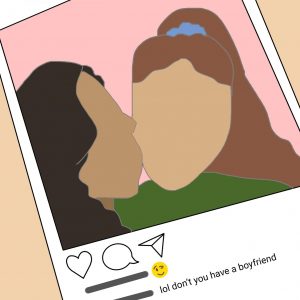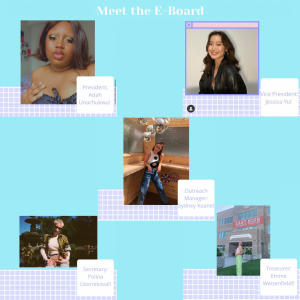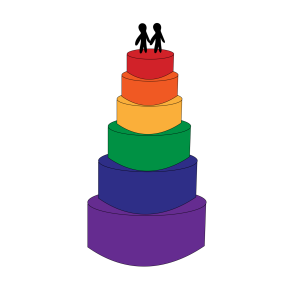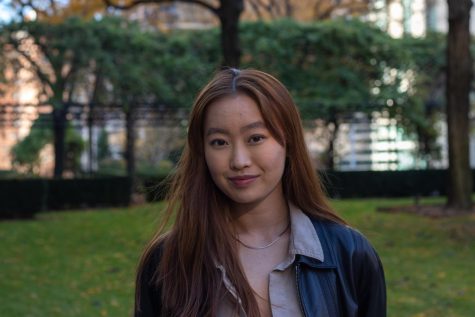The Police Do Not Belong at Pride
The police have done more harm than good for the LGBTQ+ community so participating in uniform will not make Pride a safe space
June 6, 2021
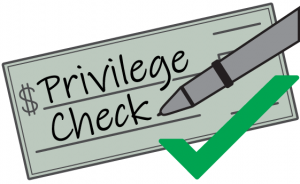 Two weeks before Pride Month officially began, the New York City Pride organizers announced that police officers and other law enforcement individuals were to be banned from marching in uniform at the Pride parade until at least 2025.
Two weeks before Pride Month officially began, the New York City Pride organizers announced that police officers and other law enforcement individuals were to be banned from marching in uniform at the Pride parade until at least 2025.
Already, op-eds from various publications have rolled out, all responding to each other and taking sides on an instantly controversial issue. This includes a staff-ed published by The New York Times boldly calling this ban a “misstep” and a piece by Washington Post columnist Jonathan Capehart feebly urging NYC Pride organizers to “let LGBTQ cops march.”
Wading through this clamor of opinions, I am disappointed — but frankly not too surprised — by just how many voices there are defending the police. Among the backlash against this ban, there are also people defending the Pride organizers’ decision. Some are pointing out that support for law enforcement officers irresponsibly minimizes the long history of mistreatment that the LGBTQ+ community has faced at the hands of the criminal justice system.
The police uniform has become a symbol of systemic oppression and violence, one that is far from reconciled with the values of NYC Pride. But even after this year of a so-called “racial reckoning” in America, the “few rotten apples” argument still hasn’t expired. The argument is used to defend the police, saying that most officers are good people and those who murder Black Americans are the exception, not the rule. This argument, however, neglects the overall harmful impacts that those “bad apples” have.
It is important to remember that the now-annual Pride march actually began as a defense against police violence inflicted on queer individuals.
Discrimination and violence against people of color, queer people and women are all systemic in this country. The sight of police uniforms invokes a deep fear among many in the LGBTQ+ community. As queer people, many of whom have other intersectional identities, safety is too important to sacrifice. Before anyone says being a cop is also an “identity,” consider that being a cop is a choice, while sexuality is not. Even if police officers want to show their support at Pride, they should come as queer and ally individuals, not as the police.
The Police Are Inherently Anti-Pride
There are more than a “few” rotten apples in the NYPD. Just as the recognition of police brutality as systemic discredits the few rotten apples argument, it is important to remember that the now-annual Pride march actually began as a defense against police violence inflicted on queer individuals.
On June 28, 1969, the police raided Stonewall Inn, a gay bar in Greenwich Village of New York City. Officers attacked patrons, arrested the bar’s clients and harassed anyone who appeared to be cross-dressing. One lesbian was hit on their head by a police officer, which led the already-angry crowd to attack the police. This resulted in the outbreak of the Stonewall Riots, with a legacy of annual Pride marches.
In 2019, the NYPD issued a long overdue apology for the actions of police officers five decades ago. In his public statement, NYPD commissioner James P. O’Neill stated, “I vow to the LGBTQ community that this would never happen in the NYPD in 2019.”
Such a vow has since been broken, invalidating what was already an overly vague statement that seemed to be made out of obligation and not sincerity.
On June 28, 2020, the Queer Liberation March for Black Lives & Against Police Brutality was met with police violence against participants. NYPD officers used pepper spray on peaceful protestors and even attacked an innocent fruit vendor on the street. Some marchers were simply dancing when police officers interrupted, aggressively pushing them down to the ground. Officers also rode their motorcycles into the bodies of demonstrators and painfully dragged one peaceful protestor.
Ignorance of such police violence against the queer community is bad enough. To claim that the NYPD’s mere efforts to appear accepting of LGBTQ+ individuals is enough for those that are harmed to tolerate their presence is inexcusable.
Police Brutality Is a Queer Issue
The criminal justice system actively works against Black, Indigenous and people of color (BIPOC) Americans, specifically Black men, perpetuating modern-day slavery in an often-overlooked way. Police brutality, mass incarceration and biases in the criminal justice system also disproportionately affect the LGBTQ+ community.
Apart from police violence against protestors and queer business owners, queer people are much more likely to be arrested and sent to juvenile detention or prison, as well as more likely to be sexually abused by others while in prison.
There is indeed overlap between the police force and the LGBTQ+ community. However, their existence still does not erase the deep systemic biases of law enforcement against queer individuals.
It is especially bad for transgender individuals. In a survey conducted nationwide by the National Center for Transgender Equality in 2015, about 61% of Black transgender individuals experienced some level of harassment by police officers. LGBTQ+ individuals also make up a large amount of the homeless population, especially among the youth. In New York City, it is common for police officers to abuse their power by kicking the homeless off of the subway when they do not have other safe spaces to sleep, part of the modern nationwide practice of criminalizing the homeless simply for being homeless.
Identity Battles: Cop versus Sexuality
There is indeed overlap between the police force and the LGBTQ+ community. However, their existence still does not erase the deep systemic biases of law enforcement against queer individuals. It is not enough to eliminate the deep fear a lot of queer people, especially queer people of color, feel at the sight of police presence.
The New York Times editorial board employed the interesting strategy of preparatory defense by opening their article with the example of Ana Arboleda, a lesbian sergeant of the NYPD. She equated the criticism against her “identity” as a cop to being thrown back into a closet. No, I can’t speak for how she feels. However, I provide a reminder that being a cop is not an identity that one is born with and actively oppressed for. It is not permanent, nor does it cause fear of rejection for simply expressing love. If you’ve made a choice to be part of a group that invokes fear for the queer community, even if you are part of that queer community, you need to respect it when other queer individuals cannot sympathize with your choice.
Pointing out that there are gay cops is detracting from the focus of the issue.
It is great that Arboleda and other LGBTQ+ police officers are able to be out as queer at their jobs, but whom do they have to thank for that? Certainly not the police. The credit goes to previous generations of queer radicals, much like the very ones that are enforcing this ban of police at Pride.
Pointing out that there are gay cops is detracting from the focus of the issue. It is essentially saying “not all cops.” Now, dare I say, tone deaf? So, there are queer cops and BIPOC cops, but it does not alleviate the pain that the criminal justice system has inflicted on these marginalized communities.
The narrative which focuses on the existence of gay cops allows people to pretend that Pride is about individuals and not about the entire LGBTQ+ community, the other oppressed communities it intersects with, and their ongoing fight to have a space in the world.
Do Queer People Really Want Cops at Pride?
The New York Times cited a Buzzfeed News article that “found 79 percent of LGBTQ Americans welcomed police participation at Pride.” This statistic, however, did not specify whether these people wanted police to participate in uniform or not. What they also failed to mention was while 90% of LGBTQ people support Pride Month’s role in liberating the queer community, only 54% have an awareness of the Stonewall Riots.
Before believing the carelessly summarized statistics, ask who exactly are these people that want police at Pride?
And of course, they did not consider that in the same survey, 56% of the people were against including black and brown stripes in the rainbow flag. This is a new design that pays homage to the fact that Pride was not only a riot against police brutality, but also that it was spearheaded by Black and Brown trans women. It is an acknowledgment of the need for more inclusion for people of color and protection for trans individuals in the queer community.
Despite the progress that has been made for LGBTQ+ individuals, it is important to realize that white, male gays benefit the most from these advancements. Unsurprisingly, then, the “strongest opposition is among gay men” while transgender and other queer people support the inclusion of stripes that represent LGBTQ+ individuals of color.
White gay males’ struggles as queer individuals are valid, but their privileges as white males are also more than prevalent. They have a responsibility to not only acknowledge their privilege but also to assist in the advancement efforts for those who do not benefit from being male or white in the community. At the very least, they need to put their ignorance aside and not hinder further underrepresented individuals’ fight for space.
Blatantly ignoring the politics of Pride is a privilege in itself.
So, before believing the carelessly summarized statistics, ask who exactly are these people that want police at Pride? Are they gay men? Specifically, are they white gay men? Do these people have any experience or awareness of the damaging role cops play in the queer community? If not, are they really the people qualified to decide whether or not police belong at Pride?
Pride Is Political
Jonathan Capehart calls for his readers to remember that Pride is a celebration of acceptance and inclusion, but fails, in his argument, to accept and include queer people and people of color who have a completely justified mistrust of the police. Pride is able to be a place of celebration because of that fact that Pride has always been and remains political. The public display of queer joy has become a substantial part of Pride due to the fact that systemic injustice has made it previously impossible. But those who spearheaded Pride and those who continue their legacy today are activists that create space for queer celebrations.
You are allowed to have fun, of course. You are allowed to celebrate your individual milestones in being a queer person or show your support as an ally. However, blatantly ignoring the politics of Pride is a privilege in itself.
As people living in New York City, one of the most LGBTQ+ friendly cities in the world, we have a responsibility to learn the importance of intersectionality for the BIPOC individuals in our community. We must recognize that liberation has yet to be achieved and not only celebrate the progress we’ve made, but also continue to push for increased acceptance and peace for our community both within the city and worldwide.
The Queer Liberation March will be at 2:30 p.m. on June 27 in Bryant Park.


